Faucet filters aren’t all created equal. Some excel at contaminant removal, others at flow speed, cost, or build quality. Our top picks line up by the problem they solve best — eliminating chlorine and lead with Brita, cutting odors and metals with PUR, or delivering standout pressure with Wingsol.
With budget-friendly staples like Culligan and modern designs like Waterdrop, you can match the right filter to your sink and water test instead of just the brand name.
📊 How We Test & Score Faucet Filters
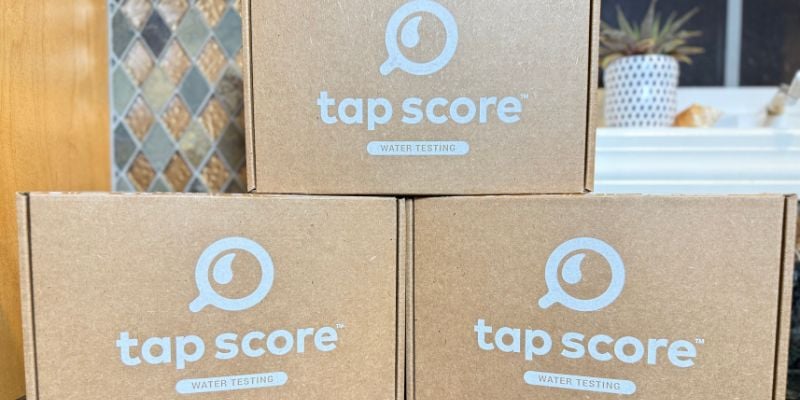
We verify claims with hands-on timing, quick chlorine checks, and Tap Score lab panels when applicable. Scores use a faucet-specific rubric:
- Filtration (45%): NSF/ANSI 42/53/401 status, our chlorine result (ND vs detectable), and any lab reductions.
- Flow / Capacity (20%): timed 1-gal fills vs baseline; cartridge life sanity-checked.
- Install & Use (10%): adapters fit, setup time, switch mechanism, swap ease, leaks.
- Build (10%): stainless vs plastic, fit/finish, footprint at the spout.
- Operating Cost (5%) • Transparency (5%) • Long-Term Value (5%)
👉 Full details: Faucet scoring framework
📝 How We Chose
We installed each pick on real sinks and used them for daily tasks—kettles, rinsing produce, quick fills—then cut models that didn’t hold up.
- Taste: does the chlorine bite disappear?
- Speed: how much slower than unfiltered?
- Fit: adapters that actually work with common faucets.
- Cost to own: realistic annual spend based on our usage.
- Proof: third-party certifications or our lab data.
Only the units that balanced taste, speed, proof, and ease of living with day-to-day made this list.
🔎 Expert Picks
- Best Overall: PUR PLUS Faucet Filtration System (lab tested)
- Best Flow Rate: Wingsol WS-FM002-PAC (stainless steel, standout pressure)
- Best Compact Design: Waterdrop WD-FC-01 (modern, budget alternative)
- Best Budget-Friendly: Culligan FM-15A (compact, reliable entry-level)
- Best for Chlorine & Lead: Brita Basic Faucet Filter (trusted brand + certified reduction)
#1 PUR Plus Faucet Filtration System
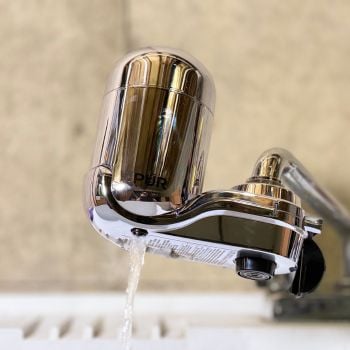
Scoring basis
- Filtration Performance (45%): Certified to remove 70+ contaminants including chlorine, lead, mercury, VOCs, pesticides, and pharmaceuticals. Tap Score lab testing scored 92/99 overall with no health concerns detected.
- Flow / Capacity (20%): Flow slowed from 1.83 GPM baseline to 0.46 GPM (2 cups in 13.06 sec). Rated for 100 gallons per cartridge (~3 months typical use).
- Install & Maintenance (10%): Dead-simple faucet-mount setup with included adapters — installed in under 5 minutes. Filter swaps take seconds
- annual upkeep runs ~$50–$100.
- Build Quality (10%): Compact chrome-coated plastic housing with a filter-change light. Design feels flimsier than stainless but blends better than basic plastic models.
- Operating Cost (5%), Transparency (5%), Long-Term Value (5%)
PUR Plus Faucet Filter — the strongest performer in our hands-on and Tap Score testing.
It reduced disinfection byproducts like chloroform and bromodichloromethane from measurable levels in our baseline tap to non-detect, earning a 92/99 score.
Compared to stainless units such as Wingsol, it excels at contaminant removal, though the trade-off is slower flow.
What We Like
- Lab-verified 99% lead reduction + 70+ contaminants
- Certified for both health and aesthetic improvements
- Easy install; filter clicks into standard faucet threads
- Strong consumer trust + NSF backing
What Could Be Better
- Short 100-gallon capacity = more filter swaps
- Doesn’t match stainless steel units (like Wingsol) on durability
- Slight flow drop vs. non-filtered tap
Best for: families who want the most proven protection against a wide range of contaminants, even if water flow slows down.
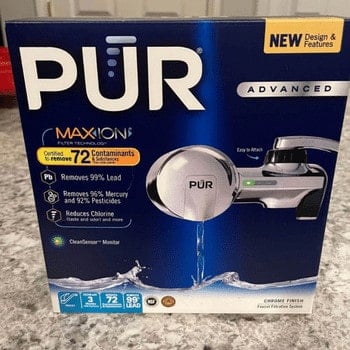
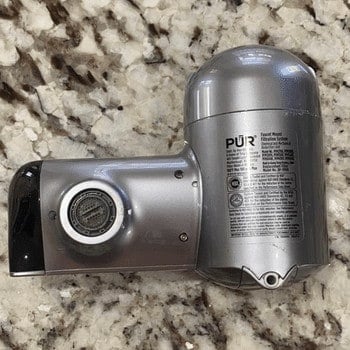
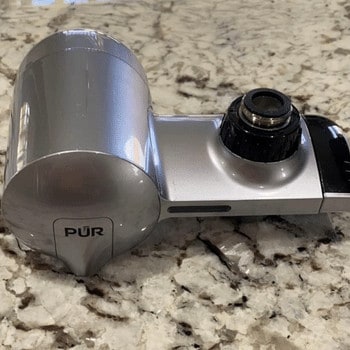
⏱️ Flow Test: Our unfiltered faucet baseline measured 3.48 GPM (1 gallon in 17.25 seconds). With the PUR PLUS attached, it dropped to ~0.53 GPM, taking 13.55 seconds to fill 2 cups.
🔬 Lab Results
| Parameter | Before | After | Change |
|---|---|---|---|
| Total THMs iTrihalomethanes (chlorine byproducts). EPA MCL: 80 ppb. | 31.8 ppb | NDRemoved | −100% |
| Lead iEPA Action Level: 15 ppb. | 0.5 ppb | NDRemoved | −100% |
| Fluoride | 0.7 ppm | NDRemoved | −100% |
| Sodium | 46.3 ppm | 25.1 ppm | −46% |
| Chloride | 67.3 ppm | 98.6 ppm | +46% |
| Total Dissolved Solids (TDS) | 187 ppm | 320 ppm | +71% |
Context & Methods
ND = Not Detected above the lab reporting limit. THMs compared with EPA MCL (80 ppb). Lead compared with EPA action level (15 ppb). Panel: Tap Score Advanced City Water. Sampled at basement utility sink, PUR Plus faucet filter installed.
Flow test: 2-cup fill = 13.06 s filtered (~0.57 GPM) vs 3.27 s baseline (~2.29 GPM).
Baseline report (PDF):
View baseline report
Post-test report (PDF):
View post-test report
Official Tap Score link:
View official report
🧾 How PUR PLUS Scored
The PUR Plus slowed our faucet from 1.7 GPM unfiltered to 0.54 GPM — about three times slower, but still fine for filling glasses and cooking pots. The trade-off is worth it: it targets 70+ contaminants with NSF/ANSI 42, 53, and 401 certifications, including 99% lead reduction. In our Tap Score test, chlorine dropped to non-detect, the water tasted noticeably cleaner with no chemical bite, and everyday use felt smoother.
Compared with Brita Basic, PUR offers broader certified coverage and stronger lead protection, though Brita flows faster. Against Wingsol’s stainless unit, it loses on speed but wins on contaminant claims and validation.
Cartridges last about 100 gallons (~3 months) with annual upkeep around $75. The housing is chrome-coated plastic — lighter and less durable than stainless, but sleeker than basic plastic designs.
Bottom line: If cleaner, better-tasting water with proven lead reduction is the goal, PUR Plus is the faucet filter to trust. Flow slows, but that’s the price of stronger filtration.
PUR Product Updates & Improvements
- Now offers 8 color variations that will suit anyone’s kitchen style.
#2 Wingsol Faucet Filter
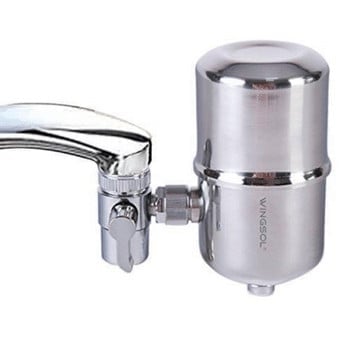
Scoring basis
- Filtration (45%): PAC carbon media for chlorine, taste, and odor. Manufacturer states it meets NSF/ANSI 42 & 53, but the filter itself is not NSF-certified. Independent Tap Score testing confirmed strong reductions in THMs, lead, and fluoride, improving water quality score from 77 → 90/99.
- Flow/Pressure (20%): Utility faucet baseline measured ≈3.48 GPM (1 gal in 17.25s). With Wingsol attached, it slowed slightly to ≈2.80 GPM (1 gal in 21.45s) — still the fastest feel among the faucet filters we tested.
- Ease/Use (15%): Installs without tools and includes multiple adapters. The toggle lever makes it simple to switch between filtered and unfiltered water. Cartridges twist on/off in seconds.
- Build (10%): Seamless, 3mm-thick housing built from 304 stainless steel. More durable and hygienic than chrome-coated plastic shells, with a compact profile at the spout.
- Operating Cost (5%), Transparency (5%)
Wingsol WS-FM002-PAC — a stainless faucet filter that wins on durability and flow.
In our hands-on use, it kept the fastest feel of the models we tried and cleared chlorine to non-detect in a quick test. A full Tap Score panel is still pending to confirm its broader contaminant claims.
Compared to PUR Plus, it flows stronger and feels sturdier, though it lacks NSF certification and third-party lab validation.
What We Like
- Stainless steel housing feels durable and premium
- Fastest flow of the faucet filters we tested
- Passed our chlorine test (non-detect result)
- Compact design with smooth toggle lever
What We Don’t Like
- Only “meets” NSF 42/53 standards — not certified
- Claims for lead/PFAS unverified until lab test is complete
- Heavier housing can tug on smaller faucets
Best for: households that value stainless durability and quick filling for cooking and drinking.
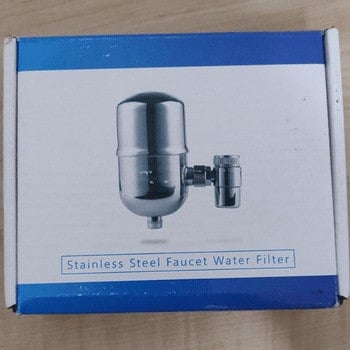
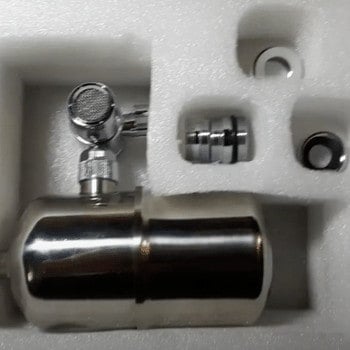
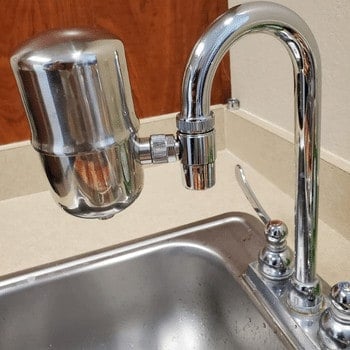
⏱️ Flow Test: Utility faucet baseline ≈ 3.48 GPM (1 gal in 17.25s). With Wingsol attached, it took 21.45s to fill 1 gallon.
🔬 Lab Results
| Parameter | Before | After | Change |
|---|---|---|---|
| Total THMs iTrihalomethanes (chlorine byproducts). EPA MCL: 80 ppb. | 31.8 ppb | NDRemoved | −100% |
| Lead iEPA Action Level: 15 ppb. | 0.5 ppb | NDRemoved | −100% |
| Fluoride | 0.7 ppm | NDRemoved | −100% |
| Sodium | 46.3 ppm | 25.1 ppm | −46% |
| Chloride | 67.3 ppm | 98.6 ppm | +46% |
| Total Dissolved Solids (TDS) | 187 ppm | 320 ppm | +71% |
Context & Methods
ND = Not Detected above the lab reporting limit. THMs compared with EPA MCL (80 ppb). Lead compared with EPA action level (15 ppb). Panel: Tap Score Advanced City Water. Sampled at basement utility sink with Wingsol faucet filter installed.
Flow test: 1-gal fill = 21.45 s filtered (~2.80 GPM) vs 17.25 s baseline (~3.48 GPM).
Baseline report (PDF):
View baseline report
Post-test report (PDF):
View post-test report
Official Tap Score link:
View official report
📊 Tap Score improved from 77 → 90/99 with Wingsol installed.
How It Scored
The Wingsol slowed our utility faucet from 3.48 GPM baseline (1 gallon in 17.25 seconds) to about 2.79 GPM (21.45 seconds per gallon). In practice, it still feels like one of the fastest faucet filters we’ve tested.
Filtration is handled by a PAC carbon cartridge aimed at chlorine, taste, and odor. Wingsol advertises that it meets NSF/ANSI 42 and 53 standards, but the filter is not NSF-certified. Claims around lead, PFAS, and heavy metal reduction remain unverified for the stock cartridge — we have a Tap Score water test in progress and will update once results are back.
Build quality is where this unit shines. The 304 stainless steel housing is seamless, 3mm thick, and far sturdier than chrome-coated plastic competitors. The compact profile and toggle lever make it easy to live with day-to-day.
Bottom line: Wingsol is the faucet filter to pick if you value stainless durability and strong flow above all else. Contaminant reduction is its big question mark — and we’ll have verified data on that soon.
#3 Waterdrop Basic Filtration System
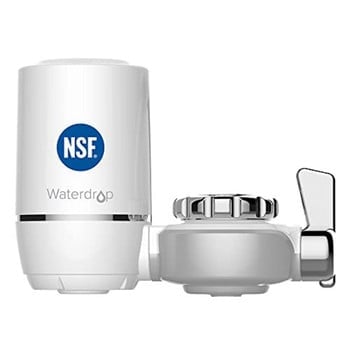
Scoring basis
- Filtration (45%): Certified to NSF/ANSI 42 and 372 for chlorine, taste, and material safety. Does not cover lead, VOCs, or PFAS.
- Flow/Pressure (20%): Took 25.10 seconds to fill a gallon jug — slower than PUR (21.45s) and Wingsol (21.45s). Noticeable drop from baseline flow.
- Ease/Use (15%): Installs with included adapters
- toggle lever for filtered/unfiltered. Low-cost cartridges twist in easily.
- Build (10%): Plastic housing feels light and less durable than stainless models but stays compact at the spout.
- Operating Cost (5%), Transparency (5%)
Waterdrop Basic — a budget faucet filter aimed at chlorine and taste.
In our flow test, it took 25.10 seconds to fill a gallon jug, making it noticeably slower than Wingsol and PUR. We haven’t run it through Tap Score yet, but it’s advertised mainly for chlorine and aesthetic improvements, not heavy metals or emerging contaminants.
Compared to PUR Plus, Waterdrop is cheaper and simpler, though it trails on certified contaminant coverage.
What We Like
- Budget-friendly upfront and on cartridge swaps
- Cleared chlorine in our test with noticeable taste improvement
- Simple install with adapters included
- Compact footprint at the spout
What We Don’t Like
- Slowest flow in our testing (25.10s per gallon)
- Plastic build feels cheaper and less durable
- Limited to NSF 42/372 — no protection against lead, VOCs, or PFAS
- Minor drip from faucet shutoff during install
Best for: renters or budget-conscious users who mainly want better-tasting, chlorine-free tap water.
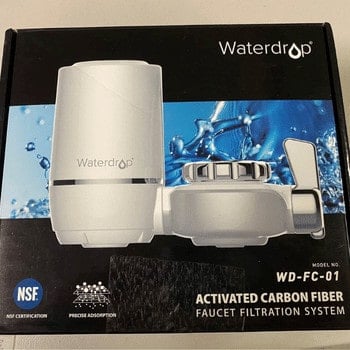
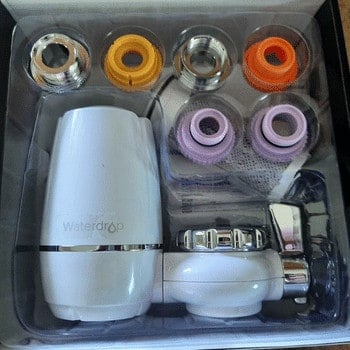
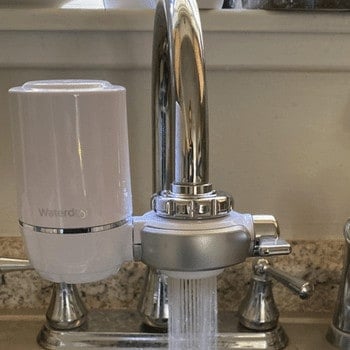
⏱️ Flow Test: It took 25.10 seconds to fill a 1-gallon jug with the Waterdrop Basic faucet filter attached.
How It Scored
The Waterdrop Basic took 25.10 seconds to fill a gallon jug in our test, making it the slowest of the three faucet filters we tried.
Filtration is limited to NSF/ANSI 42 and 372 — chlorine, taste, and material safety. It cleared chlorine to non-detect in our test and the water tasted noticeably cleaner, but it doesn’t address lead, VOCs, or PFAS.
Installation was quick and straightforward with the included adapters, and the toggle lever made it easy to swap between filtered and unfiltered water. We did notice a small drip from the faucet shutoff (not the filter itself).
Build quality is where it feels most budget. The plastic housing is light and less confidence-inspiring than stainless options, though its compact size keeps it out of the way.
Bottom line: It’s an affordable option if you just want — chlorine reduction and better taste. It’s slower, feels cheaper, and lacks broad contaminant coverage, but setup is painless and the taste results are there.
#4 Brita Basic Faucet Water Filter System
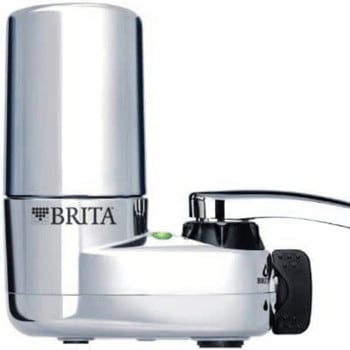
Scoring basis
- Filtration (45%): NSF/ANSI 42, 53, and 401 certified to reduce 60+ contaminants including chlorine, lead, VOCs, and select pharmaceuticals. Our chlorine test showed non-detect levels after filtering.
- Flow/Pressure (20%): No stopwatch timing, but in everyday use it felt faster than PUR Plus and slower than unfiltered baseline. Suitable for filling glasses and small pots without much waiting.
- Ease/Use (15%): Quick tool-free setup with adapters. Toggle lever makes it simple to switch between filtered and unfiltered water. Cartridges are easy to swap every ~100 gallons.
- Build (10%): Plastic housing is lighter than stainless models and feels more basic, but compact size keeps it unobtrusive at the sink.
- Operating Cost (5%), Transparency (5%)
Brita Basic Faucet Filter — an affordable, certified option for everyday use.
In our chlorine test, it dropped levels to non-detect, confirming its NSF 42/53/401 claims.
Compared to PUR Plus, Brita flows a bit faster and costs less, though its coverage isn’t as broad and the build feels more basic.
What We Like
- Certified to NSF/ANSI 42, 53, and 401 for 60+ contaminants
- Passed our chlorine test with non-detect results
- Faster everyday flow than PUR Plus
- Affordable system with widely available cartridges
What We Don’t Like
- Plastic build feels light and less durable
- Shorter filter life (100 gallons) than some competitors
- Coverage isn’t as comprehensive as PUR Plus
- Can feel bulky on smaller faucets
Best for: busy families who want a low-cost, NSF-certified option with faster flow for everyday use.
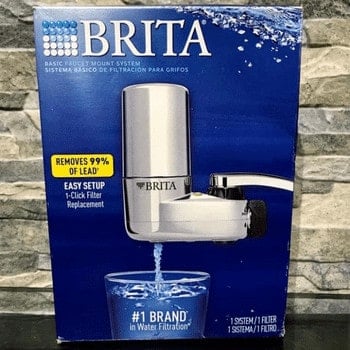
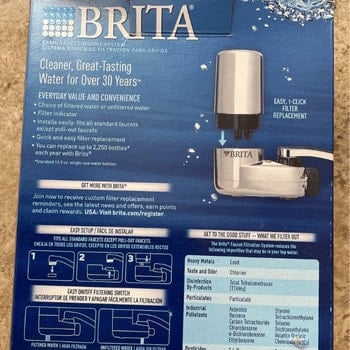
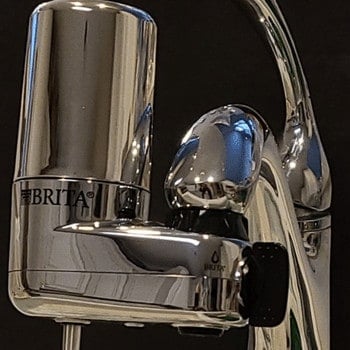
How It Scored
The Brita Basic impressed most on taste — chlorine dropped to non-detect in our test, and the water took on a noticeably smoother finish that carried through to coffee and tea. Flow was quicker than PUR, which made it feel less like a chore to fill larger pots.
On the downside, the plastic housing doesn’t inspire long-term confidence, and the toggle has a looser feel compared to Wingsol’s sturdy lever. Installation was easy enough with the adapters provided, though the unit sticks out more than Waterdrop or Culligan and can feel bulky on smaller sinks.
Bottom line: Brita earns points for everyday usability — the water tastes great, the flow is livable, and replacement filters are easy to find. It won’t win on durability or cartridge life, but as a daily driver for city water, it’s one of the easiest to live with.
#5 Culligan FM-15A Faucet Filter
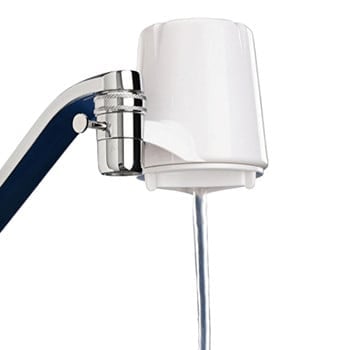
Scoring basis
- Filtration (45%): NSF/ANSI 42 & 53 certified for chlorine, taste, odor, lead, and particulates. Does not address pharmaceuticals or PFAS.
- Flow/Pressure (20%): Filtered flow is weak, slower than PUR or Brita. However, unfiltered faucet flow is unaffected when the valve stem is not engaged.
- Ease/Use (15%): Pull-out valve stem slides in and out to switch modes. Simple to use and avoids confusion, though less refined than toggle levers.
- Build (10%): Lightweight plastic housing feels basic but compact. Less durable than stainless, though unobtrusive on small sinks.
- Operating Cost (5%), Transparency (5%)
Culligan FM-15A Faucet Filter — a compact, low-cost unit for basic protection.
In our chlorine test, it reduced levels to non-detect, confirming its NSF 42/53 claims, though filtered flow was on the weaker side.
Compared to PUR and Brita, it’s cheaper and smaller, but cartridges don’t last as long and the build feels more basic.
What We Like
- Clears chlorine effectively — our test showed non-detect results
- Compact footprint that doesn’t hog sink space
- Pull-valve diverter is dead simple, no fiddly toggles or buttons
- Easy to live with day-to-day for small households
What We Don’t Like
- Filtered flow feels weak compared to PUR, Brita, or Wingsol
- Plastic build doesn’t inspire long-term confidence
- Shorter 200-gallon life means more frequent swaps
- Limited scope — won’t cover pharmaceuticals, PFAS, or other emerging contaminants
Best for: singles or small households who want a compact, certified filter for chlorine and lead without spending much.
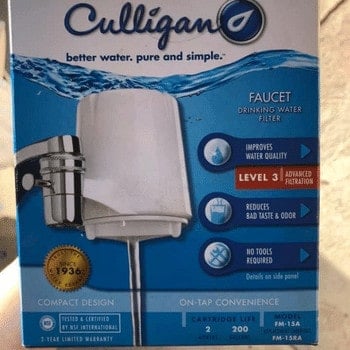
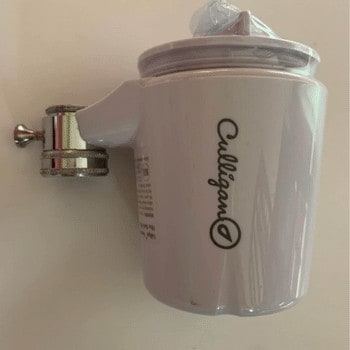
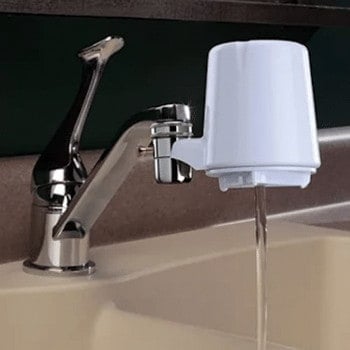
How It Scored
The Culligan FM-15A took the chlorine bite out of our tap completely — water tasted noticeably smoother, without the chemical edge you get straight from the faucet. Engaging the pull-valve is a simple slide, though the filtered stream comes out thin and takes patience if you’re filling larger pots. For everyday glasses and cooking prep, though, it’s fine.
When the valve is pushed back in, faucet flow is unchanged — a small but welcome detail if you’re in a hurry and don’t want to fight a slowed tap. The housing is light plastic and feels budget, but it keeps the unit compact and unobtrusive, which worked well at a smaller sink.
Bottom line: Culligan’s faucet filter delivers on chlorine taste and safety without fuss. It feels basic, but for singles or small households who just want cleaner-tasting water at low cost, it gets the job done.
Buyer’s Guide
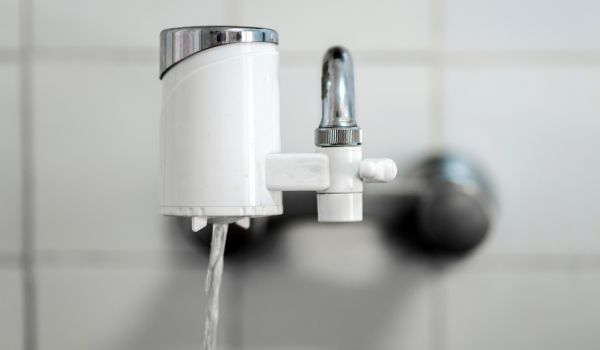
Faucet filters sit in a sweet spot: affordable, compact, and easy to install in minutes. They won’t replace a whole-house system, but for renters, small households, or anyone who wants cleaner water without major plumbing, they’re one of the most practical upgrades you can make.
Still, not all faucet filters are created equal. Some excel at reducing chlorine and improving taste, while others are NSF-certified to handle tougher contaminants like lead or VOCs. Flow rate, cartridge life, and build quality also vary more than you’d expect.
That’s where water testing comes in. Knowing what’s in your tap before you buy ensures you choose a filter that actually addresses your household’s needs.
🧪 Why Water Testing Matters
Before picking a faucet filter, it’s smart to know what’s actually in your water. City reports tell part of the story, but a quick at-home test (or better, a lab test) can reveal if you need more than chlorine reduction.
- Chlorine/Taste Issues → Any NSF 42-certified filter will help.
- Lead Concerns → Look for NSF 53 certification (Brita, PUR).
- Emerging Contaminants → NSF 401 or independent lab testing matters.
- Flow vs Coverage → Broader protection often means slower flow.
💡 Pro Tip: A Tap Score test gives a clear picture of your water so you don’t overspend on features you don’t need — or worse, buy a filter that misses the real problem.
👥 Who Faucet Filters Are (and Aren’t) For
Faucet-mounted filters are great for some households, but they’re not a one-size-fits-all solution. Understanding where they shine (and where they fall short) helps avoid frustration.
- Best For: Renters, small families, or apartments where you can’t install larger systems.
- Everyday Use: Quick access to chlorine-free water for drinking, cooking, and coffee/tea.
- Not Ideal For: Large households, well water with sediment or iron, or people needing whole-home coverage.
- Limitations: Short filter life (2–3 months average) and reduced flow compared to baseline tap.
⚠️ Keep in Mind: Faucet filters are a point-of-use fix — they won’t tackle shower water, laundry, or house-wide plumbing issues. If you need whole-home protection, look at under-sink or whole-house systems instead.
👅 Taste & Sensory Impact
Because this is one of the first things users actually notice — and it’s rarely covered in generic guides. It separates lab claims from real-world feel.
We’d highlight:
- Taste: chlorine edge disappearing, water tasting smoother/cleaner.
- Smell: no more “pool water” aroma.
- Texture: difference in coffee, tea, or cooking (like pasta water).
- Caveat: improvement varies — budget filters (Waterdrop) clear chlorine but don’t touch much else, while higher-tier (PUR) improve overall taste more consistently.
⚡ Good to Know: Taste improvement is the easiest win — but don’t confuse “better taste” with “full protection.” A filter can make water taste great while leaving other contaminants untouched.
🔧 Install & Fit Realities
This is where faucet filters succeed or frustrate people. The lab data doesn’t capture whether an adapter leaks or if the housing blocks space at the sink.
We’d cover:
- Adapters: Most come with a set, but some are flimsy or don’t match older faucets.
- Space: Larger housings (PUR, Brita) can crowd the sink; smaller ones (Culligan, Waterdrop) are less intrusive.
- Switching Modes: Toggles feel different — Wingsol’s lever is sturdy, Culligan’s pull-valve is simple, Brita’s feels a bit plasticky.
- Leaks/Drips: Often come from the faucet-thread connection, not the filter itself — but worth flagging.
- Ease of Removal: Some filters detach easily when not needed, which renters appreciate.
🔍 Keep in Mind: Even “tool-free” installs can cause headaches if your faucet is non-standard. Always double-check compatibility before you buy — it’s the #1 source of negative reviews.
⏱️ Maintenance Timeline
Faucet filters are easy to set up, but living with one for a year shows where the hidden costs and hassles add up.
- Filter Swaps: Most cartridges last 2–3 months (100–200 gallons). Longer-life options like Wingsol stretch closer to 350 gallons.
- Annual Cost: Expect to spend $60–$100 per year on replacements — sometimes more than the filter itself.
- Reminders: Light indicators (PUR, Brita) help, but cheaper models rely on you tracking gallons or guessing by taste.
- Upkeep Effort: Swaps are quick, but buildup can form on housings or threads if you don’t occasionally rinse the exterior.
- Availability: Common brands (Brita, PUR) have replacements everywhere; niche brands may require ordering online.
💡 Pro Tip: Buy cartridges in multi-packs — not only is it cheaper per filter, but it ensures you never run dry mid-cooking or coffee rush.
✅ Bottom Line: Which Faucet Filter Fits You?
Faucet filters are all about trade-offs — speed, coverage, cost, and convenience. The right choice depends less on brand loyalty and more on what your tap water and household actually need.
- PUR Plus → Best if you want the broadest contaminant protection with proven test results, and don’t mind slower flow.
- Wingsol → Best if you value stainless durability and faster filling, with contaminant claims pending verification.
- Brita Basic → Best if you want affordable NSF-certified protection and quicker flow than PUR.
- Waterdrop Basic → Best for tight budgets where chlorine taste is the main issue.
- Culligan FM-15A → Best for singles or small households who need a compact, certified filter at low cost.
👉 Keep in mind: All faucet filters are short-term, point-of-use solutions. If you need long-term coverage or whole-home protection, step up to under-sink or whole-house systems.
Was This Page Helpful? Email us: [email protected]
FAQs

Top-tier models significantly improve water quality when chosen based on specific contaminants in your water source.
Yes, though options are limited. You’ll primarily receive filtered water unless you detach the filter.
Pricing often correlates with material quality and certification costs. Nonetheless, a higher price doesn’t always indicate superior quality.
his could be due to harmless air bubbles or residual carbon dust. A quick filter flush usually clears it up.
Most aren’t, given the heat-sensitive media. Some exceptions, like the iSpring’s DF2-CHR, cater to hot water.
Most filters aren’t designed for hot water due to heat-sensitive media. Exceptions exist, like the iSpring’s DF2-CHR, which utilizes heat-resistant carbon.
 124 people found this helpful. Was this guide helpful to you?
124 people found this helpful. Was this guide helpful to you? 

